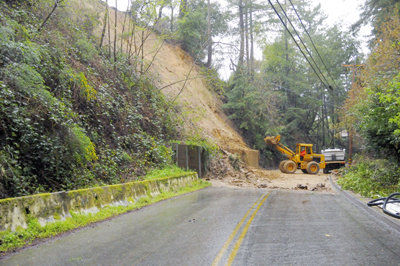
In case the San Lorenzo Valley communities felt left out following the storm damage doled out to Scotts Valley and Santa Cruz by the previous weekend’s storms, Mother Nature played a quick game of catch-up Thursday, March 24, and Saturday, March 26.
Heavy rains those days caused an estimated 30 road closures and led county authorities to order residents to evacuate low-lying homes near the San Lorenzo River, which had swelled to a depth of 19 feet, jumping the banks in a few places.
Enrique Sahagun, public information officer for the Santa Cruz County Emergency Operations Center, said that the center sent messages to 825 phones Thursday afternoon, warning residents of rising waters in the Paradise Park, Felton Grove and Gold Gulch areas along the river and recommending that they move to higher ground.
Few residents left, however, as the flood danger was short lived and the water level lowered almost visibly when the sun emerged from the clouds in the late afternoon.
“From my understanding, (river flooding) is a pretty common thing,” Sahagun said. “(The residents) know what to expect.”
Many of the homes are on stilts that were paid for by the Federal Emergency Management Agency after storms severely flooded the area in 1982.
Thursday’s evacuation order was lifted a few hours later, with only a small part of River Road experiencing knee-deep water.
“We were hoping that (the evacuation) wouldn’t be for an extended amount of time, and it worked out reasonably well,” Sahagun said.
County Emergency Services manager Paul Horvat said fallen trees in Brookdale temporarily closed Highway 9 and disrupted electricity.
Horvat also pointed out that damage was not isolated to San Lorenzo Valley, as Scotts Valley absorbed its second storm lashing in a week.
Southbound Highway 17 was closed Saturday because of a slide and forced traffic to La Madrona Drive; however, a slide blocked La Madrona, too, causing an even bigger backup that afternoon.
On Nelson Road, Santa Cruz County Sheriff’s deputies were trapped in their outpost Thursday evening near the previous week’s massive rockslide, where fallen trees boxed them in. Crews from Pacific Gas and Electric Co. reached them a few hours later.
Horvat praised the crews’ efforts.
“These guys are on top of it,” he said.
A bypass to the rockslide is being built on a man’s property to allow drivers out of the Nelson Road area.
Even they weren’t immune to nature, however, as a PG&E crew on Glenwood Drive was briefly trapped between dual washouts that same day.
Traffic on both Glen Canyon Road and Lockhart Gulch Road was subjected to one-lane stop controls following partial washouts.
Not all the news was bad, though. At 6 p.m. Thursday, Conference Drive in Mount Hermon was reopened to local traffic following a landslide the day before.
On Tuesday evening, March 29, the Santa Cruz County Board of Supervisors voted to declare a local state of emergency countywide following the storms.
Horvat said such a declaration would enable the county to seek state and federal money to help cover the costs of clearing debris, repairing infrastructure and supplying overtime pay for emergency personnel — a total estimated at $6 million.
Since July, when the record-keeping year began, Boulder Creek has received 52.3 inches of rain, after receiving 54.6 inches in the previous year. Felton has received 54.7 inches to date, compared with a total of 50.3 in the 2009-10 rainfall year, and Bonny Doon has received 67.4 inches this year, compared with 67.7 last year.
The annual average in the San Lorenzo Valley is about 50 inches per year.
Scotts Valley has received 50.45 inches of rainfall, well above its annual average of 42.7 inches in the city.
To comment, e-mail reporter Joe Shreve at jo*@*********er.com, call 438-2500 or post a comment at www.pressbanner.com.












